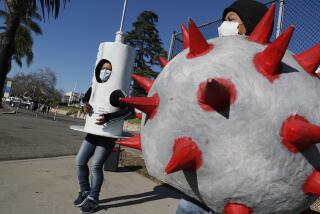Who was that masked person? In Mexico, anybody and everybody.
MEXICO CITY — The suspected narcos were paraded before the media with a telling new accessory: masks. Not the bank-robber kind. The doctor kind.
After all, even gangsters toting M-16s can get the flu.
If the swine flu outbreak in Mexico has a dominant symbol, it is the surgical mask, or tapaboca, that millions of Mexicans have adopted as requisite wear despite conflicting advice about whether it does any good.
Soldiers have handed out millions of the facial shields, which come in blue, white and hospital-scrubs green. Pharmacies in Mexico City ran out as opportunists hoarded them to sell on the street for up to $3.50 apiece -- about 50 times the normal price.
Newspapers here have carried graphics showing how to turn a piece of scrap cloth into a mask. Some people have tried to add a splash of personality by painting their masks with skeleton faces or colorful butterflies.
In a land where workaday laws are regularly ignored, Mexico City residents are pretty much obeying the government’s call to don tapabocas in public places as a way to prevent the spread of the H1N1 flu virus.
President Felipe Calderon was on national television the other night, reminding Mexicans to please cover their mouths. (Or, if they lacked a mask or handkerchief, to cough or sneeze into the crook of their arm. He even showed how.)
“I know that thanks to your systematically using the face mask, you have succeeded in reducing the chance of infection in the population,” Calderon said, mask-less, from his official residence.
“I think it’s a responsibility,” said Soledad Perez, a housecleaner in the capital’s upscale Polanco section, who was wearing a mask.
But it’s not a no-brainer. Many health experts have said the flimsy masks that are most widely available to consumers are too leaky to block the virus.
Even while Calderon was urging Mexicans to cover, his government’s top epidemiologist, Miguel Angel Lezana, was pooh-poohing mask use during a gathering of foreign journalists. He said the government was passing out millions of masks mainly because residents had asked for them.
“It makes them feel safer to have the masks, and besides, it doesn’t do any harm,” Lezana said.
That essentially leaves it to Mexicans to come up with their own reasons to cover or not -- reasons that often have as much to do with manners as public health.
Walking into a store with a bare face can make you feel a bit like you’ve lighted up in the lung ward. One commentator suggested that science was beside the point: Mask wearing, even if futile, is fundamentally an act of respect and solidarity.
Other people have settled on a hybrid approach: covering when stuck in close quarters with lots of people, such as on the subway, but not in less crowded public settings.
The tapaboca phenomenon in Mexico has yielded some incongruous images: the motorist with face covered, though alone in his car; the couple aboard a motorcycle, masked but not wearing helmets; sunbathers wearing swimsuits and surgical masks.
Newspaper columnist Juan Villoro said the mask, by revealing only the eyes, added a touch of the exotic to Mexican life. “Those who are not good-looking at least have become mysterious,” he quipped in Friday’s edition of the Reforma newspaper.
But Villoro said the flu crisis, once ended, would produce a new delight when the masks come off.
“What lesson will be left by the illness?” he asked. “Among others, the renewed surprise of seeing each other face to face.”
--
Times staff writer Tracy Wilkinson and Deborah Bonello of The Times’ Mexico City Bureau contributed to this report.
More to Read
Sign up for Essential California
The most important California stories and recommendations in your inbox every morning.
You may occasionally receive promotional content from the Los Angeles Times.










